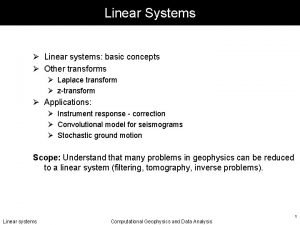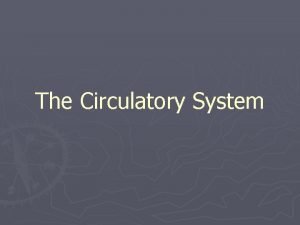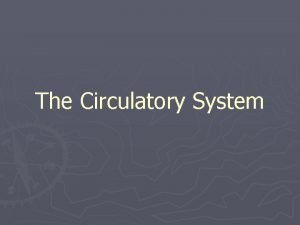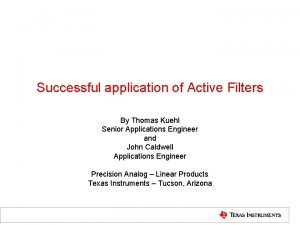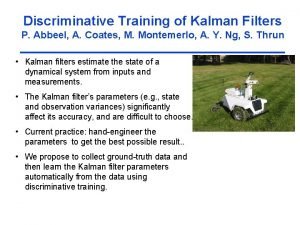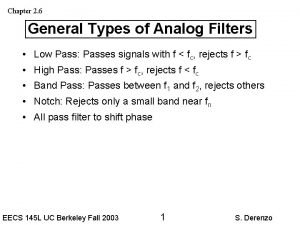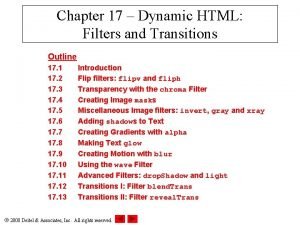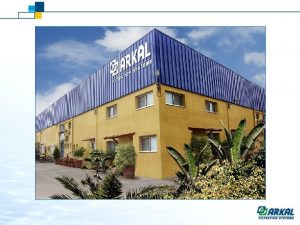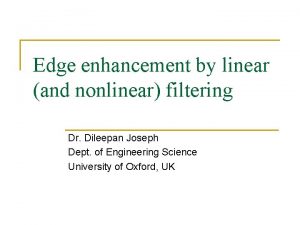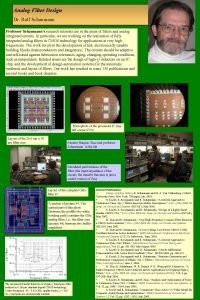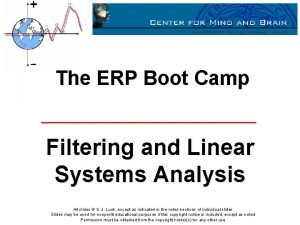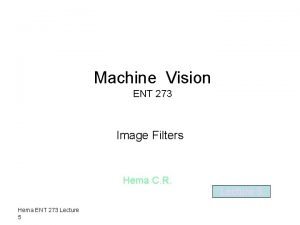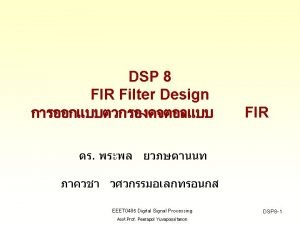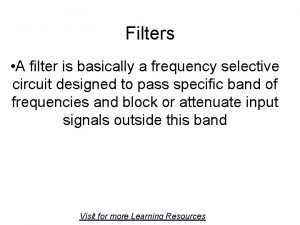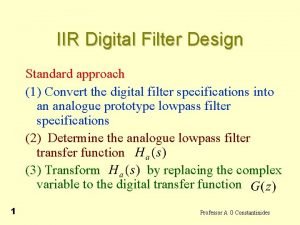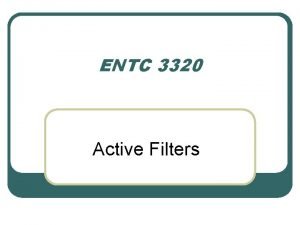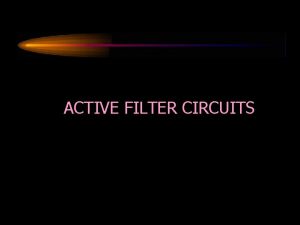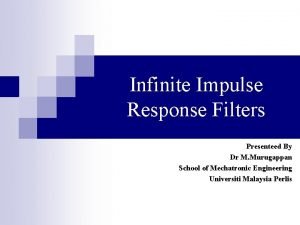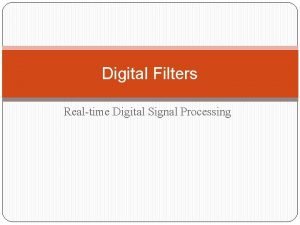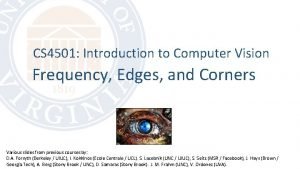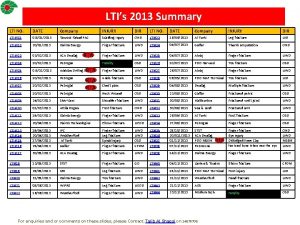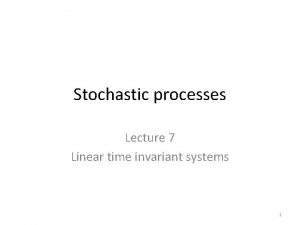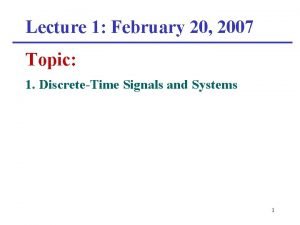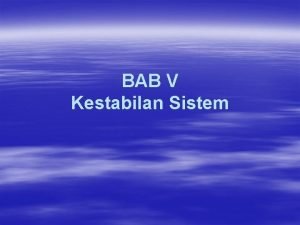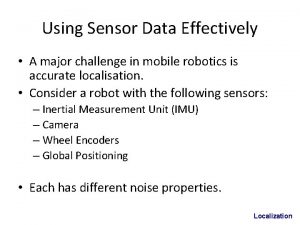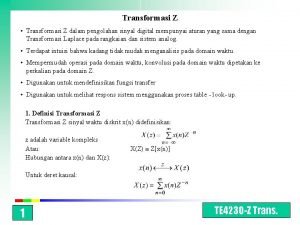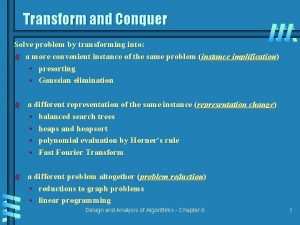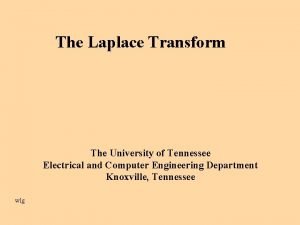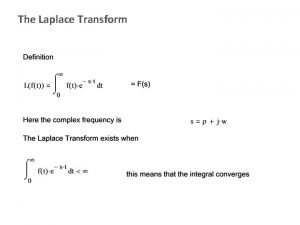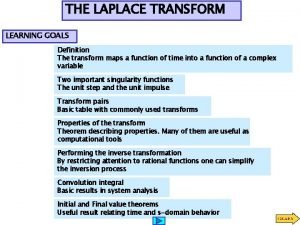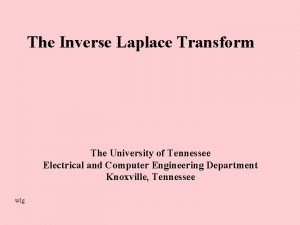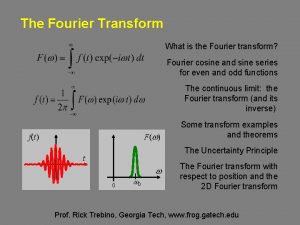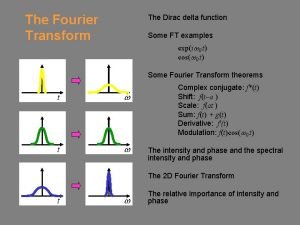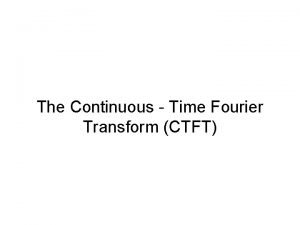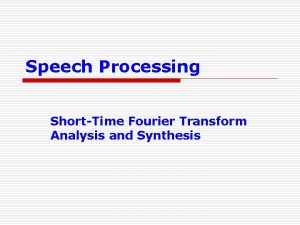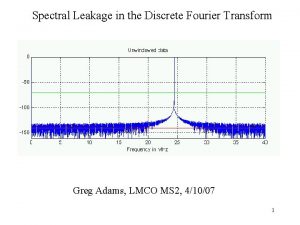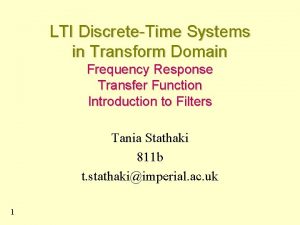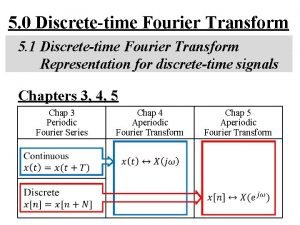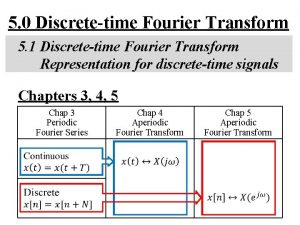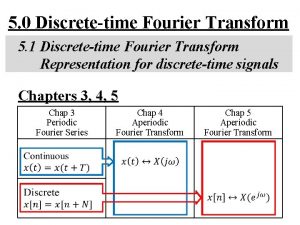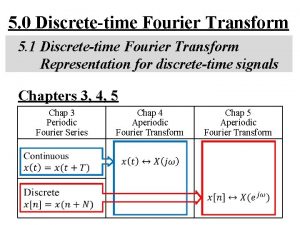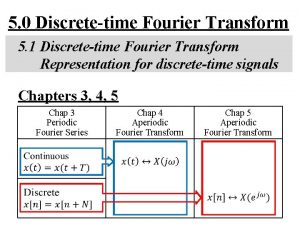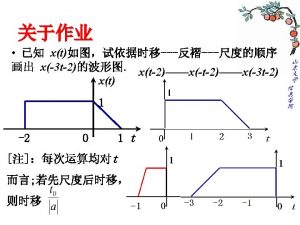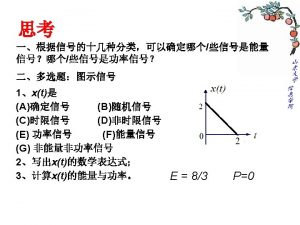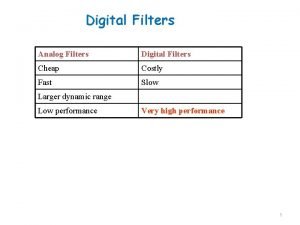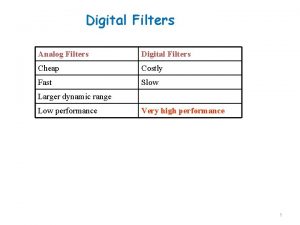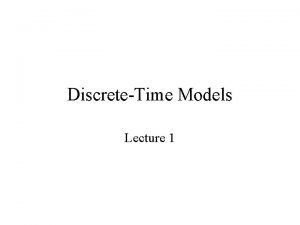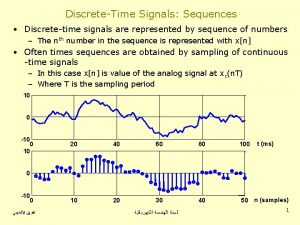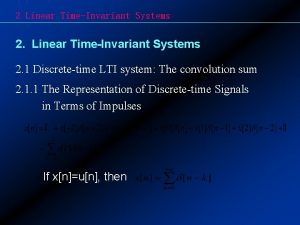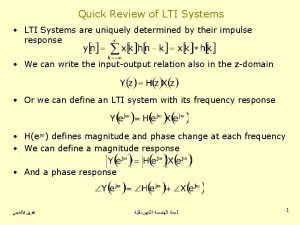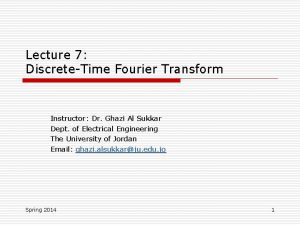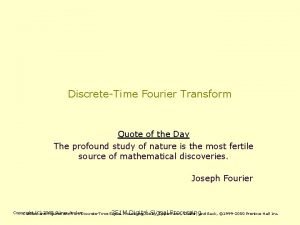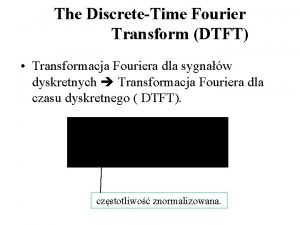LTI DiscreteTime Systems in Transform Domain Simple Filters










































































































- Slides: 106

LTI Discrete-Time Systems in Transform Domain Simple Filters Comb Filters (Optional reading) Allpass Transfer Functions Minimum/Maximum Phase Transfer Functions Complementary Filters (Optional reading) Digital Two-Pairs (Optional reading) Tania Stathaki 811 b t. stathaki@imperial. ac. uk Copyright © 2001, S. K. Mitra

Simple Digital Filters • Later in the course we shall review various methods of designing frequency-selective filters satisfying prescribed specifications • We now describe several low-order FIR and IIR digital filters with reasonable selective frequency responses that often are satisfactory in a number of applications

Simple FIR Digital Filters • FIR digital filters considered here have integer-valued impulse response coefficients • These filters are employed in a number of practical applications, primarily because of their simplicity, which makes them amenable to inexpensive hardware implementations

Simple FIR Digital Filters Lowpass FIR Digital Filters • The simplest lowpass FIR digital filter is the 2 point moving-average filter given by • The above transfer function has a zero at z = -1 and a pole at z = 0 • Note that here the pole vector has a unity magnitude for all values of w

Simple FIR Digital Filters • On the other hand, as w increases from 0 to p, the magnitude of the zero vector decreases from a value of 2, the diameter of the unit circle, to 0 • Hence, the magnitude response is a monotonically decreasing function of w from w = 0 to w = p

Simple FIR Digital Filters • The maximum value of the magnitude function is 1 at w = 0, and the minimum value is 0 at w = p, i. e. , • The frequency response of the above filter is given by

Simple FIR Digital Filters • The magnitude response is a monotonically decreasing function of w

Simple FIR Digital Filters • The frequency at which is of practical interest since here the gain in d. B is since the DC gain is

Simple FIR Digital Filters • Thus, the gain G(w) at is approximately 3 d. B less than the gain at w=0 • As a result, is called the 3 -d. B cutoff frequency • To determine the value of we set which yields

Simple FIR Digital Filters • The 3 -d. B cutoff frequency can be considered as the passband edge frequency • As a result, for the filter the passband width is approximately p/2 • The stopband is from p/2 to p • Note: has a zero at or w = p, which is in the stopband of the filter

Simple FIR Digital Filters • A cascade of the simple FIR filter results in an improved lowpass frequency response as illustrated below for a cascade of 3 sections

Simple FIR Digital Filters • The 3 -d. B cutoff frequency of a cascade of M sections is given by • For M = 3, the above yields • Thus, the cascade of first-order sections yields a sharper magnitude response but at the expense of a decrease in the width of the passband

Simple FIR Digital Filters • A better approximation to the ideal lowpass filter is given by a higher-order Moving Average (MA) filter • Signals with rapid fluctuations in sample values are generally associated with highfrequency components • These high-frequency components are essentially removed by an MA filter resulting in a smoother output waveform

Simple FIR Digital Filters Highpass FIR Digital Filters • The simplest highpass FIR filter is obtained from the simplest lowpass FIR filter by replacing z with • This results in

Simple FIR Digital Filters • Corresponding frequency response is given by whose magnitude response is plotted below

Simple FIR Digital Filters • The monotonically increasing behavior of the magnitude function can again be demonstrated by examining the pole-zero pattern of the transfer function • The highpass transfer function has a zero at z = 1 or w = 0 which is in the stopband of the filter

Simple FIR Digital Filters • Improved highpass magnitude response can again be obtained by cascading several sections of the first-order highpass filter • Alternately, a higher-order highpass filter of the form is obtained by replacing z with transfer function of an MA filter in the

Simple IIR Digital Filters Lowpass IIR Digital Filters • A first-order causal lowpass IIR digital filter has a transfer function given by where |a| < 1 for stability • The above transfer function has a zero at i. e. , at w = p which is in the stopband

Simple IIR Digital Filters • has a real pole at z = a • As w increases from 0 to p, the magnitude of the zero vector decreases from a value of 2 to 0, whereas, for a positive value of a, the magnitude of the pole vector increases from a value of to • The maximum value of the magnitude function is 1 at w = 0, and the minimum value is 0 at w = p

Simple IIR Digital Filters • i. e. , • Therefore, is a monotonically decreasing function of w from w = 0 to w = p as indicated below

Simple IIR Digital Filters • The squared magnitude function is given by • The derivative of to w is given by with respect

Simple IIR Digital Filters in the range verifying again the monotonically decreasing behavior of the magnitude function • To determine the 3 -d. B cutoff frequency we set in the expression for the squared magnitude function resulting in

Simple IIR Digital Filters or which when solved yields • The above quadratic equation can be solved for a yielding two solutions

Simple IIR Digital Filters • The solution resulting in a stable transfer function is given by • It follows from that is a BR function for |a| < 1

Simple IIR Digital Filters Highpass IIR Digital Filters • A first-order causal highpass IIR digital filter has a transfer function given by where |a| < 1 for stability • The above transfer function has a zero at z = 1 i. e. , at w = 0 which is in the stopband • It is a BR function for |a| < 1

Simple IIR Digital Filters • Its 3 -d. B cutoff frequency is given by which is the same as that of • Magnitude and gain responses of are shown below

Example 1 -First Order HP Filter • Design a first-order highpass filter with a 3 d. B cutoff frequency of 0. 8 p • Now, and • Therefore

Example 1 -First Order HP Filter • Therefore,

Simple IIR Digital Filters Bandpass IIR Digital Filters • A 2 nd-order bandpass digital transfer function is given by -2 æ ö a 1 1 z ç ÷ H BP ( z ) = 2 çè 1 - b(1 + a) z -1 + a z -2 ÷ø • Its squared magnitude function is

Simple IIR Digital Filters • goes to zero at w = 0 and w = p • It assumes a maximum value of 1 at , called the center frequency of the bandpass filter, where • The frequencies and where becomes 1/2 are called the 3 -d. B cutoff frequencies

Simple IIR Digital Filters • The difference between the two cutoff frequencies, assuming is called the 3 -d. B bandwidth and is given by • The transfer function is a BR function if |a| < 1 and |b| < 1

Simple IIR Digital Filters • Plots of are shown below

Example 2 -Second Order BP Filter • Design a 2 nd order bandpass digital filter with center frequency at 0. 4 p and a 3 -d. B bandwidth of 0. 1 p • Here and • The solution of the above equation yields: a = 1. 376382 and a = 0. 72654253

Example 2 -Second Order BP Filter • The corresponding transfer functions are and • The poles of are at z = 0. 3671712 and have a magnitude > 1

Example 2 -Second Order BP Filter • Thus, the poles of are outside the unit circle making the transfer function unstable • On the other hand, the poles of are at z = and have a magnitude of 0. 8523746 • Hence, is BIBO stable

Example 2 -Second Order BP Filter • Figures below show the plots of the magnitude function and the group delay of

Simple IIR Digital Filters Bandstop IIR Digital Filters • A 2 nd-order bandstop digital filter has a transfer function given by • The transfer function is a BR function if |a| < 1 and |b| < 1

Simple IIR Digital Filters • Its magnitude response is plotted below

Simple IIR Digital Filters • Here, the magnitude function takes the maximum value of 1 at w = 0 and w = p • It goes to 0 at , where , called the notch frequency, is given by • The digital transfer function commonly called a notch filter is more

Simple IIR Digital Filters • The frequencies and where becomes 1/2 are called the 3 -d. B cutoff frequencies • The difference between the two cutoff frequencies, assuming is called the 3 -d. B notch bandwidth and is given by

Simple IIR Digital Filters Higher-Order IIR Digital Filters • By cascading the simple digital filters discussed so far, we can implement digital filters with sharper magnitude responses • Consider a cascade of K first-order lowpass sections characterized by the transfer function

Simple IIR Digital Filters • The overall structure has a transfer function given by • The corresponding squared-magnitude function is given by

Simple IIR Digital Filters • To determine the relation between its 3 -d. B cutoff frequency and the parameter a, we set which when solved for a, yields for a stable :

Simple IIR Digital Filters where • It should be noted that the expression given above reduces to for K = 1

Example 3 -Design of an LP Filter • Design a lowpass filter with a 3 -d. B cutoff frequency at using a single first-order section and a cascade of 4 first-order sections, and compare their gain responses • For the single first-order lowpass filter we have

Example 3 -Design of an LP Filter • For the cascade of 4 first-order sections, we substitute K = 4 and get • Next we compute

Example 3 -Design of an LP Filter • The gain responses of the two filters are shown below • As can be seen, cascading has resulted in a sharper roll-off in the gain response Passband details

Comb Filters • The simple filters discussed so far are characterized either by a single passband and/or a single stopband • There applications where filters with multiple passbands and stopbands are required • The comb filter is an example of such filters

Comb Filters • In its most general form, a comb filter has a frequency response that is a periodic function of w with a period 2 p/L, where L is a positive integer • If H(z) is a filter with a single passband and/or a single stopband, a comb filter can be easily generated from it by replacing each delay in its realization with L delays resulting in a structure with a transfer function given by

Comb Filters • If exhibits a peak at , then will exhibit L peaks at , in the frequency range • Likewise, if has a notch at , then will have L notches at , in the frequency range • A comb filter can be generated from either an FIR or an IIR prototype filter

Comb Filters • For example, the comb filter generated from the prototype lowpass FIR filter has a transfer function • has L notches at w = (2 k+1)p/L and L peaks at w = 2 p k/L, , in the frequency range

Comb Filters • Furthermore, the comb filter generated from the prototype highpass FIR filter has a transfer function • has L peaks at w = (2 k+1)p/L and L notches at w = 2 p k/L, , in the frequency range

Comb Filters • Depending on applications, comb filters with other types of periodic magnitude responses can be easily generated by appropriately choosing the prototype filter • For example, the M-point moving average filter has been used as a prototype

Comb Filters • This filter has a peak magnitude at w = 0, and notches at , • The corresponding comb filter has a transfer function whose magnitude has L peaks at and notches at , ,

Allpass Transfer Functions Definition • An IIR transfer function A(z) with unity magnitude response for all frequencies, i. e. , is called an allpass transfer function • An M-th order causal real-coefficient allpass transfer function is of the form

Allpass Transfer Functions • If we denote the denominator polynomials of as : then it follows that can be written as: • Note from the above that if is a pole of a real coefficient allpass transfer function, then it has a zero at

Allpass Transfer Functions • The numerator of a real-coefficient allpass transfer function is said to be the mirrorimage polynomial of the denominator, and vice versa ~ • We shall use the notation to denote the mirror-image polynomial of a degree-M polynomial , i. e. , ~

Allpass Transfer Functions • The expression implies that the poles and zeros of a realcoefficient allpass function exhibit mirrorimage symmetry in the z-plane

Allpass Transfer Functions • To show that • Therefore • Hence, we observe that

Allpass Transfer Functions • Now, the poles of a causal stable transfer function must lie inside the unit circle in the z-plane • Hence, all zeros of a causal stable allpass transfer function must lie outside the unit circle in a mirror-image symmetry with its poles situated inside the unit circle • A causal stable real-coefficient allpass transfer function is a lossless bounded real (LBR) function or, equivalently, a causal stable allpass filter is a lossless structure

Allpass Transfer Functions • The magnitude function of a stable allpass function A(z) satisfies: • Let t(w) denote the group delay function of an allpass filter A(z), i. e. ,

Allpass Transfer Functions • The unwrapped phase function of a stable allpass function is a monotonically decreasing function of w so that t(w) is everywhere positive in the range 0 < w < p • The group delay of an M-th order stable real -coefficient allpass transfer function satisfies:

Allpass Transfer Function A Simple Application • A simple but often used application of an allpass filter is as a delay equalizer • Let G(z) be the transfer function of a digital filter designed to meet a prescribed magnitude response • The nonlinear phase response of G(z) can be corrected by cascading it with an allpass filter A(z) so that the overall cascade has a constant group delay in the band of interest

Allpass Transfer Function G(z) • Since A(z) , we have • Overall group delay is the given by the sum of the group delays of G(z) and A(z)

Minimum-Phase and Maximum. Phase Transfer Functions • Consider the two 1 st-order transfer functions: • Both transfer functions have a pole inside the unit circle at the same location and are stable • But the zero of is inside the unit circle at , whereas, the zero of is at situated in a mirror-image symmetry

Minimum-Phase and Maximum. Phase Transfer Functions • Figure below shows the pole-zero plots of the two transfer functions

Minimum-Phase and Maximum. Phase Transfer Functions • However, both transfer functions have an identical magnitude as • The corresponding phase functions are

Minimum-Phase and Maximum. Phase Transfer Functions • Figure below shows the unwrapped phase responses of the two transfer functions for a=0. 8 and b=-0. 5

Minimum-Phase and Maximum. Phase Transfer Functions • From this figure it follows that has an excess phase lag with respect to • Generalizing the above result, we can show that a causal stable transfer function with all zeros outside the unit circle has an excess phase compared to a causal transfer function with identical magnitude but having all zeros inside the unit circle

Minimum-Phase and Maximum. Phase Transfer Functions • A causal stable transfer function with all zeros inside the unit circle is called a minimum-phase transfer function • A causal stable transfer function with all zeros outside the unit circle is called a maximumphase transfer function • Any nonminimum-phase transfer function can be expressed as the product of a minimum-phase transfer function and a stable allpass transfer function

Complementary Transfer Functions • A set of digital transfer functions with complementary characteristics often finds useful applications in practice • Four useful complementary relations are described next along with some applications

Complementary Transfer Functions Delay-Complementary Transfer Functions • A set of L transfer functions, , , is defined to be delaycomplementary of each other if the sum of their transfer functions is equal to some integer multiple of unit delays, i. e. , where is a nonnegative integer

Complementary Transfer Functions • A delay-complementary pair can be readily designed if one of the pairs is a known Type 1 FIR transfer function of odd length • Let be a Type 1 FIR transfer function of length M = 2 K+1 • Then its delay-complementary transfer function is given by

Complementary Transfer Functions • Let the magnitude response of be equal to in the passband less than or equal to in the stopband where and are very small numbers • Now the frequency response of can be expressed as ~ where ~ is the amplitude response

Complementary Transfer Functions • Its delay-complementary transfer function has a frequency response given by ~ ~ ~ • Now, in the passband, ~ and in the stopband, • It follows from the above equation that in ~ the passband, and in the ~ stopband,

Complementary Transfer Functions • As a result, has a complementary magnitude response characteristic, with a stopband exactly identical to the passband of , and a passband that is exactly identical to the stopband of • Thus, if is a lowpass filter, will be a highpass filter, and vice versa

Complementary Transfer Functions • At frequency ~ at which ~ the gain responses of both filters are 6 d. B below their maximum values • The frequency is thus called the 6 -d. B crossover frequency

Example 4 • Consider the Type 1 bandstop transfer function • Its delay-complementary Type 1 bandpass transfer function is given by

Example 4 • Plots of the magnitude responses of and are shown below

Complementary Transfer Functions Allpass Complementary Filters • A set of M digital transfer functions, , , is defined to be allpasscomplementary of each other, if the sum of their transfer functions is equal to an allpass function, i. e. ,

Complementary Transfer Functions Power-Complementary Transfer Functions • A set of M digital transfer functions, , , is defined to be powercomplementary of each other, if the sum of their square-magnitude responses is equal to a constant K for all values of w, i. e. ,

Complementary Transfer Functions • By analytic continuation, the above property is equal to for real coefficient • Usually, by scaling the transfer functions, the power-complementary property is defined for K = 1

Complementary Transfer Functions • For a pair of power-complementary transfer functions, and , the frequency where , is called the cross-over frequency • At this frequency the gain responses of both filters are 3 -d. B below their maximum values • As a result, is called the 3 -d. B crossover frequency

Complementary Transfer Functions • Consider the two transfer functions and given by where and transfer functions • Note that • Hence, and complementary are stable allpass are allpass

Complementary Transfer Functions • It can be shown that and are also power-complementary • Moreover, and are boundedreal transfer functions

Complementary Transfer Functions Doubly-Complementary Transfer Functions • A set of M transfer functions satisfying both the allpass complementary and the powercomplementary properties is known as a doubly-complementary set

Complementary Transfer Functions • A pair of doubly-complementary IIR transfer functions, and , with a sum of allpass decomposition can be simply realized as indicated below

Example 5 • The first-order lowpass transfer function can be expressed as where

Example 5 • Its power-complementary highpass transfer function is thus given by • The above expression is precisely the firstorder highpass transfer function described earlier

Complementary Transfer Functions • Figure below demonstrates the allpass complementary property and the power complementary property of and

Complementary Transfer Functions Power-Symmetric Filters • A real-coefficient causal digital filter with a transfer function H(z) is said to be a powersymmetric filter if it satisfies the condition where K > 0 is a constant

Complementary Transfer Functions • It can be shown that the gain function G(w) of a power-symmetric transfer function at w = p is given by • If we define , then it follows from the definition of the power-symmetric filter that H(z) and G(z) are powercomplementary as

Complementary Transfer Functions Conjugate Quadratic Filter • If a power-symmetric filter has an FIR transfer function H(z) of order N, then the FIR digital filter with a transfer function is called a conjugate quadratic filter of H(z) and vice-versa

Complementary Transfer Functions • It follows from the definition that G(z) is also a power-symmetric causal filter • It also can be seen that a pair of conjugate quadratic filters H(z) and G(z) are also power-complementary

Example 6 • Let • We form • H(z) is a power-symmetric transfer function

Digital Two-Pairs • The LTI discrete-time systems considered so far are single-input, single-output structures characterized by a transfer function • Often, such a system can be efficiently realized by interconnecting two-input, twooutput structures, more commonly called two-pairs

Digital Two-Pairs • Figures below show two commonly used block diagram representations of a two-pair • Here and denote the two outputs, and denote the two inputs, where the dependencies on the variable z have been omitted for simplicity

Digital Two-Pairs • The input-output relation of a digital twopair is given by • In the above relation the matrix t given by t is called the transfer matrix of the two-pair

Digital Two-Pairs • It follows from the input-output relation that the transfer parameters can be found as follows:

Digital Two-Pairs • An alternative characterization of the twopair is in terms of its chain parameters as where the matrix G given by G - - is called the chain matrix of the two-pair

Digital Two-Pairs • The relation between the transfer parameters and the chain parameters are given by

Two-Pair Interconnection Schemes Cascade Connection - G-cascade - • Here - - -

Two-Pair Interconnection Schemes • But from figure, and • Substituting the above relations in the first equation on the previous slide and combining the two equations we get • Hence,

Two-Pair Interconnection Schemes Cascade Connection - t-cascade - • Here - - -

Two-Pair Interconnection Schemes • But from figure, and • Substituting the above relations in the first equation on the previous slide and combining the two equations we get • Hence,

Two-Pair Interconnection Schemes Constrained Two-Pair G(z) H(z) • It can be shown that
 Equation fourier
Equation fourier Introduction to functions (review game)
Introduction to functions (review game) Z domain to frequency domain
Z domain to frequency domain Fourier series of trapezoidal waveform
Fourier series of trapezoidal waveform![What is the z - transform of anu[n] and -anu[-n-1] What is the z - transform of anu[n] and -anu[-n-1]](data:image/svg+xml,%3Csvg%20xmlns=%22http://www.w3.org/2000/svg%22%20viewBox=%220%200%20200%20200%22%3E%3C/svg%3E) What is the z - transform of anu[n] and -anu[-n-1]
What is the z - transform of anu[n] and -anu[-n-1] Z transform tutorial
Z transform tutorial Domain specific vs domain general
Domain specific vs domain general Domain specific software engineering
Domain specific software engineering Problem domain vs knowledge domain
Problem domain vs knowledge domain S domain to z domain
S domain to z domain What are language processing activities
What are language processing activities Wet etch and clean filters
Wet etch and clean filters Filters in weka
Filters in weka Lymph nodes: “filters of the blood”
Lymph nodes: “filters of the blood” Lymph nodes: “filters of the blood”
Lymph nodes: “filters of the blood” Applications of active filters
Applications of active filters Ironport outbreak filters
Ironport outbreak filters Discriminative training of kalman filters
Discriminative training of kalman filters Columbus industries el paso
Columbus industries el paso Types of analog filters
Types of analog filters Filters and transitions in dhtml
Filters and transitions in dhtml Disc filters galaxy 4 spin klin series
Disc filters galaxy 4 spin klin series Difference between linear and nonlinear spatial filters
Difference between linear and nonlinear spatial filters Custom air filters
Custom air filters Rolf schaumann
Rolf schaumann Time frequency domain
Time frequency domain Machine vision
Machine vision Hpf lpf bpf
Hpf lpf bpf What is large volume parenterals
What is large volume parenterals Our personal filters assumptions
Our personal filters assumptions Practical frequency selective filters basically
Practical frequency selective filters basically Opinion and argument
Opinion and argument Joint legacy viewer training
Joint legacy viewer training Spectral transformation of iir filters
Spectral transformation of iir filters Advantages of active filters
Advantages of active filters Disadvantages of low pass filter
Disadvantages of low pass filter Bacterial filters ppt
Bacterial filters ppt Perceptual filters
Perceptual filters Emfab filters
Emfab filters Impulse invariant method formula
Impulse invariant method formula Digital filters
Digital filters Asp.net mvc 5 identity authentication and authorization
Asp.net mvc 5 identity authentication and authorization Universal xss
Universal xss Event list filters packet tracer
Event list filters packet tracer Skimage.filters.gaussian
Skimage.filters.gaussian Barracuda web filter 310
Barracuda web filter 310 Pdo lti
Pdo lti Pdo accident
Pdo accident Ct lti system
Ct lti system Associative property of lti system
Associative property of lti system Xv-lti 026
Xv-lti 026 Who made this
Who made this Time invariant system
Time invariant system Sistem lti
Sistem lti Lti pdo
Lti pdo Lti pdo
Lti pdo Pdo lti
Pdo lti Lti pdo
Lti pdo Pdo
Pdo Impulse response of lti system examples
Impulse response of lti system examples Lti hse
Lti hse California lti training
California lti training Lti belfast
Lti belfast Pdo lti
Pdo lti Pdo lti
Pdo lti Pdo lti
Pdo lti Monkeyboard winch
Monkeyboard winch Lti hse
Lti hse Pdo lti
Pdo lti Pdo lti
Pdo lti Pdo lti 2020
Pdo lti 2020 Lti hse
Lti hse Pengertian lti
Pengertian lti Present simple past simple future
Present simple past simple future Simple present and simple future
Simple present and simple future Past continuous present simple
Past continuous present simple Without information
Without information Simple present, simple past, simple future
Simple present, simple past, simple future Present simple past simple future simple present continuous
Present simple past simple future simple present continuous Future tense of like
Future tense of like Simple present exemplos
Simple present exemplos Present simple past simple future simple
Present simple past simple future simple Decision support systems and intelligent systems
Decision support systems and intelligent systems Engineering elegant systems: theory of systems engineering
Engineering elegant systems: theory of systems engineering Embedded systems vs cyber physical systems
Embedded systems vs cyber physical systems Engineering elegant systems: theory of systems engineering
Engineering elegant systems: theory of systems engineering Simple mechanical systems examples
Simple mechanical systems examples Transform sc
Transform sc Wced mantra 2022
Wced mantra 2022 Transform and conquer
Transform and conquer Localisation sensor data
Localisation sensor data Power bi extract transform load
Power bi extract transform load Pengertian transformasi z
Pengertian transformasi z Rumus transformasi z
Rumus transformasi z Passive voice my mother makes cakes on sunday
Passive voice my mother makes cakes on sunday Transform and conquer algorithm example
Transform and conquer algorithm example Transform and conquer technique
Transform and conquer technique Z transform table
Z transform table Initial value theorem of laplace transform
Initial value theorem of laplace transform Inverse laplace transform
Inverse laplace transform Laplace transform of 1
Laplace transform of 1 Inverse laplace transform formula
Inverse laplace transform formula Sinc to rect
Sinc to rect Fourier transform of dirac delta function
Fourier transform of dirac delta function Duality of fourier transform
Duality of fourier transform Short time fourier transform applications
Short time fourier transform applications Fourier series coefficients formula
Fourier series coefficients formula
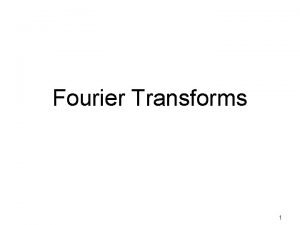



![What is the z - transform of anu[n] and -anu[-n-1] What is the z - transform of anu[n] and -anu[-n-1]](https://slidetodoc.com/wp-content/uploads/2020/12/2676408_bc1105d747f6a28db864208443624449-300x225.jpg)




